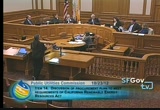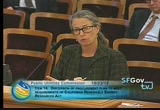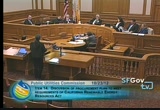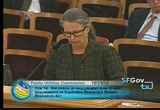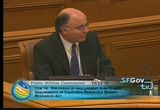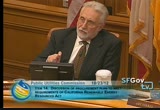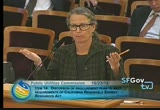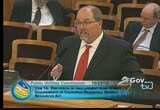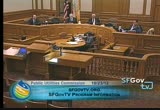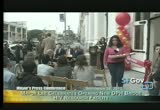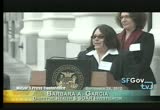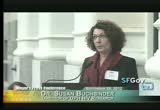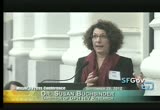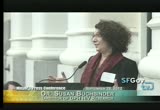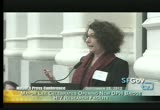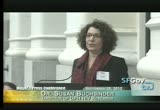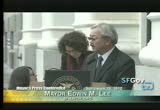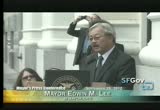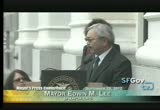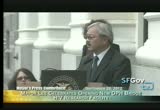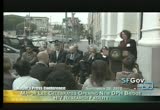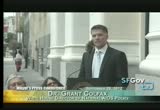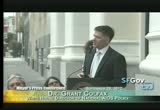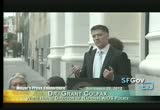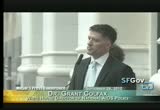tv [untitled] October 24, 2012 10:00am-10:30am PDT
10:00 am
customers in future budget years. it's really a safety valve to make sure that our compliance doesn't push costs up unreasonably. president torres, you alluded to the timeline. let me put it up on the screen here so that you can see more specifically where we're at. >> right, that's good for the public to see that. >> yes. >> my other question is in terms of the rps eligible, the renewables, what percentage are we looking at in terms of renewables? we have solar, wind -- >> right. so, now our resource mix is our biogas, our hydro and solar. >> okay. >> and because we have this separate section of the rps law, we don't have to procure beyond those resources except very infrequently. and we are proposing that that
10:01 am
procurement be from renewable energy credits. >> so, the way they're titled would be appropriate? >> they would be. they would be qualified resources under state law. >> if we had -- >> if we had them, yes. >> and we have no geo thermal here? >> correct. we have purchased it in the part, but we do not have any in our portfolio today. >> where do we purchase it from? >> we purchase from the geo thermal system in guyser. >> in guyser ville? >> yes. >> are they acceptible our hydro now? >> yes, commissioner, they are accepting our hydro. yeah, another hooray, that's three in one meeting. [laughter] >> we have -- we were able through the legislative process to explain that were we to have the same rules applied to us, we would just be selling our hydro and substituting in other renewable resources. the objective of the law is to
10:02 am
in part to reduce the emissions from power plants. we don't have any power plants that emit. >> [inaudible]. >> yeah, i have a couple of questions. so, we can't bank the rps resources? >> we can. under the rules, we can -- if we have -- if we do that math equation and we have lots of extra rps compliant power, we can bank those renewable energy credits. you earlier allowed us to register with us the western system that allows folks to have those credits certified in a way that's recognized by the marketplace. we are registering those credits, then, and we can use them ourselves in a subsequent compliance year. so, for example, in this year because last year was wet, 2011 was wet, we had some extra. this year we're going to need to purchase some, but we're also taking some of what we
10:03 am
generated last year and applying it to this year. so, we're not having to purchase as much as we otherwise would have. >> and they don't expire? >> they do expire. under the regulations, they do expire. so, we would either use them or if we projected that we wouldn't need them, we would attempt to sell them before they expire. so, we extract the value one way or the other. >> that was my other question. and then i thought we budgeted in our budget for some additional renewable procurement. >> yes, we do have additional renewable procurement in our budget. some of that capacity, if you will, that financial capacity is absorbed by the power purchase agreement we have with sunset, for the sunset soler output. but we also recognize that even in any year, what we may need may need we exceed forecast. we're looking at the risk
10:04 am
management part of our line item to fund these unusual circumstances. >> and when was the last time that we weren't able to meet our needs? and i know that these rps standards are new, so, maybe we didn't have the same issues. >> we didn't have the same requirement. >> but have we been able to meet our needs with hetch hetchy with our parr? >> there have been times we had to meet short-term purchases in order to meet our needs. and maybe the best way to look at that is to again look at the first background slide i put up where you can see there are some years where a lot of our generation is considerably lower. you could tell that our retail sales pretty much track a wet year. not exactly, but in recent years, sorry, they pretty much track a dry year. so, the dry year line you see on this slide here is about where our retail sales are or have been in the last 10 or so
10:05 am
years. and, so, looking at these -- the tail end of this slide here, you can see although years we have plenty of power to cover our retail sales. >> so, one of the things this slide doesn't give you is sort of like that day to day sort of variation that happens. that's an annual sort of like slide. and when you look at it sort of by quarter or by month, great, you have lots of power in april, may, june, and you have very little in september, october, november. until the rain starts and the snow starts again. so, if there is a cycle that kind of goes on and we do do short term purchases in what we call quarter 3 and quarter 4. just to cover, you know, our existing customers. >> and that's why we'd be procuring the recs this year, right? >> yes. this is a lower than normal water year and we've had some outages. >> right. >> thank you very much.
10:06 am
>> anybody have any questions? yes, commissioner moran. >> on the -- on page 12 of the presentation where you talk about the cost limitation proposal. >> yes. >> and you have $100 per megawatt hour. >> yes. >> which is twice what the penalty level is that was set by the cpuc for pg&e. >> yes. >> what is the thinking as to why we doubled that? why do we choose to have a twice what the cpucd? >> one is a penalty is one is a cost limitation. it could certainly be lower if you prefer a lower -- to cap the amount the puc will pay at a lower level, we could. it was really just -- we're just providing that as a benchmark for you to understand sort of some of the context in which we're proposing this number. >> and the market for renewables ranges from currently what to what?
10:07 am
>> it's also about 30 to 50 megawatt premium on top of the brown power. brown power price. >> so, 30 do $50 per megawatt hour premium? >> yes. >> and this says that it would be market -- in case of an adverse market which is probably when we would most likely need to buy this stuff, it gives us some price flexibility there. >> right. to the extent that we are low on hydro -- california is low on hydro, and, so, market prices are going to be up overall as a result. >> thank you. >> what is the impact of the deductions on solar utilization? have we measured that? tax deductions that are -- >> have we measured that? we certainly realize that it lowers the cost. >> right. >> and that's why we pursued a third-party for our development of the sunset solar project. >> okay. >> and didn't fund it ourselves. i can't recall off the top of
10:08 am
my head, maybe you do, todd, what the -- mr. reedstrom, what the financial impact of that was for us. >> it was pretty significant. by way of comparison, the tax credit, tax credit financing that we successfully undertook for current sunset solar brought the average cost per kilowatt hour down to 23-1/2 cents. that compares to average costs of our hydro system. all the costs included of about 9 cents. so, without the tax credit federal financing as well as the state programs, it would have been over 30 cents kilowatt hour. >> you need to take credit for that. >> we have a line item -- >> that's why i try to raise some of these issues because when you and the work that this agency has been doing, i am so proud of the fact that the cost saving that ultimately go to the rate payer, we need to talk about. if we're going to get your trumpet so you can blow your horn, we'll do that. you should be commended because
10:09 am
you've been taking into account, you've been a steady steward of the process and look what it's producing for the rate payer here in san francisco. i'm sure most jurisdictions, knowing some of the mayors in those other jurisdictions, i don't think they've had as good a record as we've had here in san francisco. i want to say thank you. i think it's important to bring it out into the public view. >> thank you. it's definitely a team effort. a lot of detail. >> no question it's a team effort. my comments were directed to the team. any other comments? we don't need to accept anything. [speaker not understood]. >> there's no action. >> right, no action necessary. i guess there is an action necessary to go into executive session, closed session. >> thank you. >> any public comments before we move into closed session? all right, we need a motion to assert the attorney/client privilege. >> move to assert the attorney/client privilege. >> second. all those in favor signify by saying aye. >> aye. >> all right. >> closed session items, item
10:10 am
17, existing litigation lennon versus city and county of san francisco. item 18, existing litigation cadmin versus city and county of san francisco. item 19, existing claim, chung versus city and county of san francisco. and item 20, existing litigation city and county of san francisco versus pacific run and gun club. >> let the record show that the private session [inaudible]. >> i would like to make a motion not to disclose -- [inaudible]. >> [inaudible]. >> aye. >> [inaudible]. [adjourned]
10:11 am
>> okay, if we can have everybody take their seats. okay, good morning. we're going to get warm because you're all together. but we really want to welcome all of you today to the opening of our new city, new bridge hiv research facility. let's give it a hand. [cheering and applauding] >> one of the greatest honors that i have and barbara garcia, the director of health and one of the greatest honors i have is the critical staff that i get to work with. and one of those incredible staffs is going to be susan
10:12 am
[speaker not understood]. [cheering and applauding] >> susan is a premiere doctor in our community, in our san francisco general hospital focused on hiv and aids. ands as importantly and sometimes even more, her importance of being a researcher in the area of hiv and aids and is a renowned world leader in this area. by the way, we have many of you who are, well, world renowned researchers also in the midst of all of us. i'm the principal investigator on this project and that means that i'm supposed to be in charge of making sure it happens. so, we're 70% done and you're seeing one of the major parts of it today. and i want to introduce susan so we can get the show on the road. so, thank you so much. (applause) >> well, i want to welcome you
10:13 am
all here today for the launch of our state offices aids renovation project otherwise known as soar. and i'm susan buck binder. i'm speaking on behalf of the entire aids office. we are fortunate to be a world class research organization housed within the health department which is pretty much unique globally. we have three amazing sections that we work with. the first is the surveillance epidemiology section. they really started at the very beginning of the hiv epidemic in tracking what was then known as grid and other term and became aids and then also tracking new cases of hiv infection. and, so, there's really been leaders around the world in how to track trends in new infections and that is what helps us drive both our prevention and our treatment program. they share their data around the world. they are leaders in helping
10:14 am
other organizations around the world set up their own surveillance group. this was led by dr. susan sheer and dr. willie mcfar land and i want to acknowledge them and their entire team. (applause) >> the hiv prevention section formerly led it now it's led by tracy packer who is here in the crowd. (applause) >> and stacey leads an amazing team of people. they not only oversee and set the priorities for hiv prevention in the entire city and serve as really, again, one of the flagship prevention programs globally in making decisions about how to have the biggest impact on driving down new infections. but they're also a world class
10:15 am
research organization that does research on testing, on linkage to care, community viral load, treatment of substance use as a way to prevent new hiv infections. and she, again, has a very difficult verse and very talented team and we're really excited to work with them as well. (applause) >> and then finally i want to introduce my staff. we were formally known as the hiv research section. but as you can see we have these other world class research organizations housed in our same institution. so, we've renamed ourselves bridge hiv. and i'm going to tell you a little story because i have sitting here. we got a grant from the tap root organization, which is a group that does pro bono work for nonprofit organizations in a variety of areas. and tim led two of our projects, one of which was to help us rename ourselves
10:16 am
because we knew that it was confusing for us to be called the hiv research section when so many of us do research. we are called bridge hiv because we're a bridge to the east bay, to our international collaboraters, from the past, the very beginning of the epidemic when there was a research study called the san francisco clinic city cohort study or the hepatitis b cohort study, that specimens from is that study were used to develop the very first hiv antibody test to where a link to the past and the future. so, we're a link to the past and the future, and more than anything we're a link to the community. and our motto is where science meets community. our team does really cutting edge research on different kinds of prevention strategies, pre-exposure prophylaxis. and if you go to our website, join prep hiv, you'll see all of the many exciting studies that we have as well as our
10:17 am
partnership with san francisco city clinic in launching the first demonstration project of pre-exposure prophylaxis, taking antihiv medicines to prevent new infections. we're studying topical gels, retro microbicide. the way we're going to end this epidemic is through a vaccine, we've controlled other infectious diseases through a cure. we're proud of our staff who contribute to this as well as the many study participants. and i'm just going to close with a quick word about the project. the way that this project came about was actually one of our staff members, janey vincent who is our graphic designer, you'll see some of her beautiful work inside, noticed that there was -- she's hiding. (applause)
10:18 am
>> she noticed that president obama had designated part of his stimulus money to nih for the national institutes of health and they were putting a billion dollars to research infrastructure, biomedical research infrastructure, something that's never happened before. she said, you know, we don't have enough space in our section. all of the three units had grown so much that we really needed more space. she said, do you think we could apply for this money? and, so, the three units came together and our goals were one, to be able to fully really advance the science that we're doing by enrolling large diverse groups of study participants and we didn't have enough room to do that. the second was that we wanted to increase the space that we have so we could share collaboratively so we could work together with each other. and the third was really to engage with community. and we didn't have a large
10:19 am
community space on-site. and, so, you'll see the space, see the additional clinical space that we've added. you'll see the additional rooms that we've added for conferences, formal and informal gatherings to staff as well as video conferencing capabilities for a greenway of communicating with our colleagues globally. and then finally, we're going to have a very beautiful, large community stage, it's that stage of the construction is not complete but you'll get a chance to see the status of that. so, again, i want to thank you all. and i now want to welcome mayor ed lee. we're so proud to have mayor lee here to be in the city led by mayor lee. and, again, none of this could happen, none of our activities could happen without the support of the city. that's what makes us such a unique organization. it's what -- we've always had such strong support from the city. so, mayor lee, thank you. (applause) >> thank you.
10:20 am
thank you, susan and barbara, and thank you all for coming out today on this ribbon cutting on a very, very important center of research. we have never given up on this fight to end aids, and i am so thankful to be working with supervisor scott weaner and supervisor david campos and the board of supervisors. and we have through the budget year in and year out, and particularly this last couple years, where state and federal funds may have been waiting. we stood up and said, we are continuing this fight at the highest level to make sure we fund everything we can to end this aids epidemic. you know, i've been in the city working and the numbers came out. there were 20,000 people that died of this dreaded disease. there were over 20,000 people, more still are suffering from the aids epidemic and we need to find those cures. and, so, today is a delightful
10:21 am
day because it is now again a part of the innovation spirit of this city that we create the clinical resources that we need, the laboratories that we need to invite the doctors and the researchers to come here and help us discover the latest efforts and to make sure we continue that progress. and i'm here today to thank a lot of the people that include dr. buck binder and barbara and the wonderful health commission that has been working, but also just a few years ago, if you saw what the center was -- and i used to work in this building at the top level, a barbecue up front of all placeses, a saloon, people used to wear their boots to have the greatest barbecue they could have. and working that out with the hiv unit and research of our public health, working with our
10:22 am
real estate, working with our department of technology and our city administrator. but ultimately working with our department of public works and mohammed at the helm, making sure this got done on time within budget, having the architects and engineers under [speaker not understood] working with the expert laboratory folks from dh and the hiv clinic to make sure that we did it right. because the laboratories have to meet federal standards. but i think also a great kudos has to happen to our partners, both locally, regionally, and the federal government. we could not have done this without the 9-1/2 million dollars of recovery monies that we got through the federal government. we have herb schultz here from the department of human services federal government. they've been really at the forefront with us.
10:23 am
certainly dan bernel representing leader pelosi. she has been really a stalwart fighter. when everybody was cutting funds, she preserved that money for us. and, of course, i've got to put out a big, big thanks to president obama because without that recovery money, we wouldn't be here talking about this today. so, thank you, president obama. (applause) >> and leader pelosi, federal partners working with our local folks here. that's how we get these things done. and then i want to just give a special shout out to dr. colvax who is here. i know he gave such you an incredible dedication when he was the head of the hiv unit while he was here. we're changing stories now that he's at the head of the national office on hiv policy and the national policy office. how wonderful he thinks of san francisco now and he has to go and interact with washington. (applause)
10:24 am
>> they probably talk about that in a minute. but everybody that i know that ever has to go to washington, d.c. or any other place, that they came from san francisco. we know what they're doing here. we know we have a strong partnership and it's community-based agencies also that are helping make this connection because our residents and the people with aids wouldn't trust us if we didn't do it the way in which we collaborated so strongly with our neighbors, with our residents and our community-based agencies, with all of the different agencies that are represented here. and i am privileged, very, very privileged to thank all of the partners here today to have 17,000 square feet of research space that will be used to its utmost to join in discovering the latest drugs, the latest prevention cures, to have a safe place for people who have contacted and been victims of aids to come here and tell us
10:25 am
what's going on in their lives. help us help them help the rest of the world figure this out. this is what san francisco does. i am very, very proud of everyone who participates in this high level of interchange. so, again, thank you very much and i look forward to these great discoveries that we'll have. thank you, san francisco, for being a great place. [cheering and applauding] >> thank you, mayor lee. and in addition to the stimulus money that we have to thank president obama for, we also have to thank him for his wise choice of the director of the white house office of national aids policy, dr. brad colfax. [cheering and applauding] >> well, good morning, everybody. isn't the fog great? [laughter] >> after spending the summer in d.c., i can say i will never, ever be critical of fog again.
10:26 am
[laughter] >> and as many of you know, i had the privilege before going to the office of national aids policy in d.c. to work for the health department for 15 years under barbara's inspirational leadership and susan's incredible mentor ship and supervision. it's just been fantastic to go to d.c. and realize what incredible history and progress san francisco has and continues to make and help guide us at the national level in terms of the epidemic. today the celebration of bridge research is just another step forward, a huge step forward in the city's remarkable leadership at the local, national, and international level in hiv prevention care and treatment. and the bridge research team, the history has just been remarkable in terms from the early days of the epidemic, in terms of the natural history of
10:27 am
the disease, vaccine research, prevention measures, prophylaxis, treatment, testing technologies. as susan was saying, bringing this all together was integrating with surveillance work, with prevention work, and with community-based organizations. and this is really the san francisco model that really resonates in terms of how we approach the epidemic. the research is eloquent, it's rigorous, and it involves community at all levels. and that is something i think we really need to celebrate about what bridge research means today. so, at the office of national aids policy, our job is to implement the president's national hiv/aids strategy. the president released the strategy two years ago. this is the first strategy for the -- first comprehensive strategy for the united states since the first epidemic. it has three main health outcome goals, to reduce hiv
10:28 am
incidents, to improve health and wellness outcomes for people living with hiv, and to reduce hiv-related disparities. i'm sure that sounds familiar to many of you because that's certainly aligned with many of the san francisco's efforts. the fourth goal is to develop a more comprehensive coordinated response to the epidemic nationally and this is something that we really have been working on at the federal level and also bringing forward the state and local responsibility in terms of how we address this epidemic. and i just want to really acknowledge the mayor's support at the local level, making sure that federal, state and local resources are brought forward to address this epidemic and it is something that we are really committed to as we move forward, continuing to implement the strategy. and we have our work cut out for us. at the entertioner international aids conference in july this year, the cdc
10:29 am
reported that only 25% of people living in the united states with hiv has a suppressed viral load. so, only one quarter of people have reached outcomes that we really know is so important for people to live healthier lives when they're living with hiv. the 25% is really of concern. and when you look at the disparities in hiv, those numbers are even more concerning for people of color. so, as we move forward to health equity, our focus is really how do we help people access testing, how do we help people access care in their communities. and certainly while these numbers are something that we would all like to see higher, we think there is a huge opportunity, transformative opportunity to move forward in improving these as a nation and that is the affordable care act. and i just want to acknowledge herb and his work and hhs's work in implementing the affordable care act under the outstanding leadership of secretary sebelius. some of these numbers are so
130 Views
IN COLLECTIONS
SFGTV: San Francisco Government Television Television Archive
Television Archive  Television Archive News Search Service
Television Archive News Search Service 
Uploaded by TV Archive on

 Live Music Archive
Live Music Archive Librivox Free Audio
Librivox Free Audio Metropolitan Museum
Metropolitan Museum Cleveland Museum of Art
Cleveland Museum of Art Internet Arcade
Internet Arcade Console Living Room
Console Living Room Books to Borrow
Books to Borrow Open Library
Open Library TV News
TV News Understanding 9/11
Understanding 9/11
